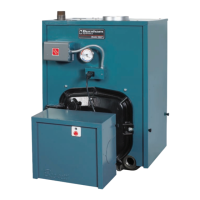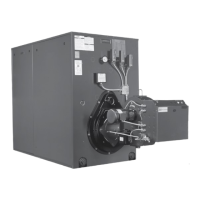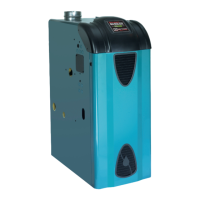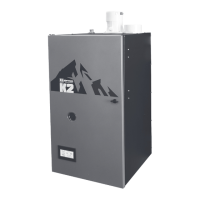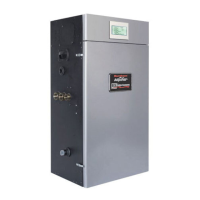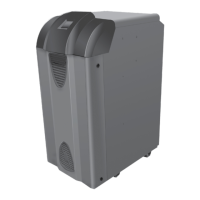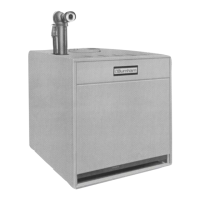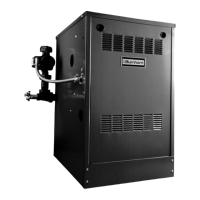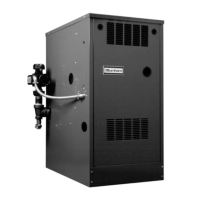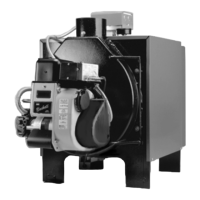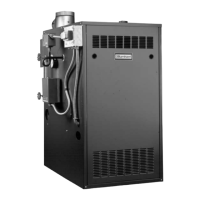42
L. BOILER PIPING, DOMESTIC HOT WATER
(DHW) APPLICATION – The V9A boiler can be
used in many dierent piping applications to produce
Domestic Hot Water (DHW). In some applications,
depending on the control strategy (outdoor reset,
setpoint operation, etc.) and size of boiler, it is
recommended to isolate the space heating load from
the DHW load. For example, if the domestic load is
more than the space heating load, it is benecial to
dedicate one or more boilers solely to DHW production
and one or more other boilers to solely space heating,
since during mild weather conditions, the boiler(s)
will have more capacity than is required. Piped in the
recommended manner, the space heating boiler(s) can
be shut down during the summer months to conserve
energy and to avoid short cycling. This section will
address four methods of piping and controlling
domestic hot water generation.
1. Hot Water Boiler/Tankless Coil(s) - Tankless
coils, mounted into the side of the boiler, have
been used successfully for many years and may
be used in single and multiple boiler applications.
When a boiler is arranged with tankless coils, it
is not recommended that outdoor reset be used,
unless there are control systems in place to prevent
overheating of the space heating zones.
Figure 32a depicts the addition of an automatic
mixing valve to the tankless heater piping to obtain
a dual temperature domestic system. The mixing
valve provides tempered water to the xtures,
while the branch prior to the valve provides high
temperature water for dishwashing, washing
machines and other appliances.
2. Hot Water Boiler/Tankless Coils/Storage Tank - This
application involves the use of several tankless coils
piped in parallel, emptying into a large storage tank,
and is typically used in larger DHW production
applications, such as hotel showers and laundries.
See Figure 32b for recommended piping and wiring
details for this type of application. The tempering
valve and recirculation loop are advantageous in
these applications, because they provide both high
temperature and tempered domestic hot water to
the system, eliminating the need to purge and waste
water until it reaches the desired temperature.
In the case where the boiler is used for domestic
production only, and there is no space heating
involved, a destratication pump is utilized to
provide ow within the boiler. This ow acts as a
means of preventing the hot water from stratifying
at the top of the boiler. Destratication pump ow
rates are given in the table in Figure 32b.
3. Hot Water Boiler/Indirect Water Heater - The use
of indirect water heaters for domestic hot water
generation is common and somewhat advantageous
over tankless coils alone, since they also provide
DHW storage. A tempering valve and recirculating
pump are again recommended for a dual temperature
system, to provide a constant temperature to the
xtures without waiting for cooler water to warm
up. Figure 32c shows a typical indirect heater piping
application with no space heating. Indirect pump
ow rates are calculated based on a 20°F DT.
DO NOT use the boiler circulator as an indirect domestic
hot water system circulator.
NE PAS utiliser le circulateur de la chaudière comme
circulateur indirect du système d’eau chaude sanitaire.
When possible, domestic hot water production should utilize a dedicated boiler(s). This will allow the other boiler(s) to
be shut down and isolated during the summer months. If the boiler load is shared between heating and domestic hot
water, then one needs to determine if a hot water priority is required. If a priority is not selected, erratic domestic hot
water production may result during the beginning and end of every heating season. Conversely, a priority for domestic
hot water production may cause a signicant heating zone activation delay, in an improperly balanced system. Parallel
piping conversions may require isolation from the heating system to prevent system ow inuence on DHW performance.
Consult a qualied system heating professional to design for the proper application.
Lorsque cela est possible, la production d’eau chaude sanitaire doit utiliser une ou plusieurs chaudières dédiées. Cela
permettra aux autres chaudières d’être arrêtées et isolées pendant les mois d’été. Si la charge de la chaudière est
partagée entre le chauage et l’eau chaude sanitaire, il faut alors déterminer si une priorité d’eau chaude est requise. Si
une priorité n’est pas sélectionnée, une production d’eau chaude sanitaire irrégulière peut se produire au début et à la
n de chaque saison de chauage. À l’inverse, une priorité pour la production d’eau chaude sanitaire peut entraîner un
retard d’activation de la zone de chauage important, dans un système mal équilibré. Les conversions de tuyauteries
parallèles peuvent nécessiter une isolation du système de chauage pour éviter toute inuence du débit du système
sur les performances d’ECS. Consultez un professionnel qualié en chauage de système pour concevoir l’application
appropriée.
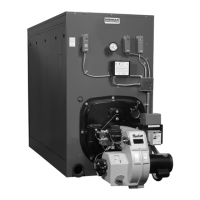
